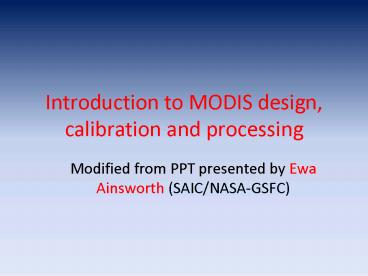Introduction to MODIS design, calibration and processing - PowerPoint PPT Presentation
1 / 8
Title:
Introduction to MODIS design, calibration and processing
Description:
Introduction to MODIS design, calibration and processing. Modified from PPT ... Stray-light contamination. Solar Diffuser stability. Stray-light contamination ... – PowerPoint PPT presentation
Number of Views:108
Avg rating:3.0/5.0
Title: Introduction to MODIS design, calibration and processing
1
Introduction to MODIS design, calibration and
processing
- Modified from PPT presented by Ewa Ainsworth
(SAIC/NASA-GSFC)
2
(No Transcript)
3
MODIS design and calibration
SD Solar Diffuser, primary source for the
absolute radiometric calibration of VIS and NIR
bands SDSM Solar Diffuser Stability Monitor,
alternately views the Sun through an attenuation
screen and the light diffusely reflected from the
SD and ratios the obtained radiances SRCA
Spectroradiometric Calibration Assembly SWIR
short-wave IR MWIR medium-wave IR LWIR
long-wave IR FPA Focal Plane Assembly
4
Sensor characterization and calibration concerns
- Mirror degradation, Response Versus Scan-angle
(RVS), two mirror sides - Detector calibration changes
- Polarization sensitivity
- In-band and out-of-band response
- Instrument and focal plane temperature effects
- Electronic cross-talk
- Stray-light contamination
- Solar Diffuser stability
- Solar Diffuser characterization
- Bi-directional Reflectance Factor (BRF) impact on
calibration - Earth shine effect sunlight reflecting off the
Earth and onto the diffuser and adding to the
solar irradiance - Attenuation screen characterization through
vignetting function - SDSM uncertainty in monitoring SD reflectance
changes
- Stray-light contamination
- Photons in the optical path from Earth coming
from bright sources, i.e. clouds, land, and sun
glitter (characterized by point spread function)
5
MODIS calibration stages
- Direct calibration
- Pre-launch sensor is calibrated in a laboratory
(thermal vacuum) - On-orbit regular solar, deep-space, and lunar
observations track changes in sensor response
(possible additional on-board calibrators) - Absolute radiometric accuracy
- reflective solar bands (0.41 2.1?m) 2 in
reflectance and 5 in radiance - thermal emissive bands (3.7 14.4?m) 1 for
most bands - Vicarious calibration uses sources independent
of the primary direct calibration in situ
measurements
6
MODIS-Aqua daily
1 August 2007
MODIS-Terra daily
7
MODIS data
- ATT EPH
- spacecraft attitude
- spacecraft position
- Level 0
- raw digital counts
- native binary format
- GEO
- geolocation
- radiant path geometry
- Level 1A
- raw digital counts
- HDF formatted
- Level 1B
- calibrated
- radiances
- converted
- telemetry
8
Native satellite vs. map projection
cylindrical isotropic projection
increasing pixel size
bow-tie effect






























